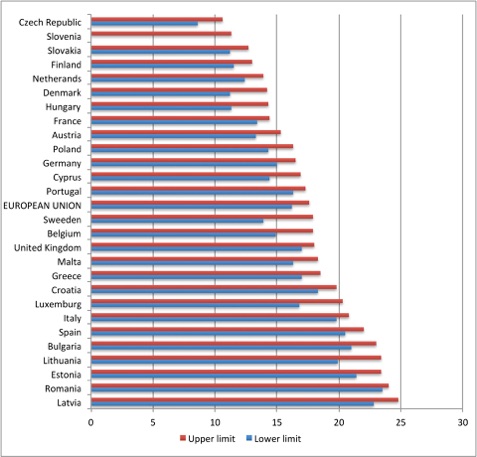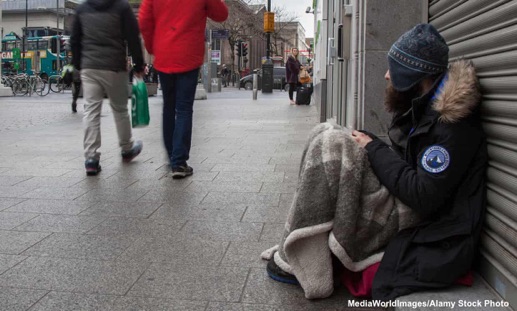News
9 November 2019
In Europe, one of the richest regions in the world, more than one person out of six lives in poverty
In December 2012, we published an article that triggered reactions of surprise among our readers, in which we had stressed the growing poverty observed in rich countries [read in French]. For many, poverty refers to the situation in the so-called « developing » countries. In reality, poverty is a global phenomenon that is fed by the incredible growth of inequalities observed in world over the last decades [read]. These inequalities are a consequence of the way our global economic system operates [read] and of the way our governments use borders [read].
EUROSTAT estimates that, in 2018, approximately 16 to 17% of the population of the 28 European Union countries, equivalent to 83 to 90 million people, were at-risk of poverty, i.e. “had an equivalised disposable income (after social transfers) below the at-risk-of-poverty threshold, which is set at 60 % of the national median equivalised disposable income after social transfers”. The diagramme below shows the situation in each of the 28 countries of the Union.
Share of the population of countries of the European Union
at-risk of poverty (2018)

Source: EUROSTAT
Download diagramme: Poverty.jpg
According to these estimates, there were more than 9 million poor in France, more than 11 million in the UK and more than 12.5 million in Germany.
The first edition of the report on poverty in France 2018 (in French) published by the Observatoire de la pauvreté and Le compas estimate that “between 2006 and 2016, the number of poor increased [in France] by 630,000 at the 50% of median income while at the same time national GDP increased by 7% or 170 billion euros”, this being a continuation of the « rise of poverty after the year 2000 [which] constitutes a break in the social history of our country”.
This evolution is the result of an “unequal income distribution”. So France does not stand out as an exception in the general trend of aggravation of inequalities in the world, even though France’s social system allowed it to better absorb the shock of the 2008 crisis than the majority of EU countries. There has, for example, been an increase of more than 30% of the households receiving the RSA (Income of active solidarity, a form of French social welfare) between 2007 and 2017 (+380,000 households).
The report of the Observatoire adds that if one takes as poverty threshold 50% of the median income (855 euros or 900 dollars/month in 2016), the number of poor is around 6 million (9 million if this threshold is set at 60% or 1,026 euros - 1,080 dollars/month - as does EUROSTAT). The poor in France are mainly people living in a single-parent family, who are unqualified, young and living in large cities and their suburbs. For the sake of comparison, the median income in France was 1710 euros (1803 dollars/month), while the threshold of the 10% richest was 3131 euros (3300 dollars/month).
Earlier this month, Secours Catholique (Caritas France) published its “State of poverty in France 2019” (État de la pauvreté en France en 2019 - in French) based on the observation, throughout the country, of more than 72,000 situations (out of the total of 1,347,500 persons hosted in 2018).
This document shows clearly that poverty in France strikes particularly women (56,4% of the persons hosted, of whom 32% isolated women) and children (46% of the accompanied persons) and that poor families have seen their income reduced, a change “explained in part by the increase of the share of households not receiving any resources and, among them, households with no access to jobs”.

The report also provides descriptions of the situation in each region of the country and emphasises the growing share among hosted persons of foreign refugees (6.4% in 2018 compared to less than 1% in 1999).
In the UK, a report presenting results of a household survey showed that in 2019 22% of the population (14.3 million people) was poor according to the definition adopted by the Social Metrics Commission (SMC), an independent body created in 2016. Half of these poor were living in a situation of persistent poverty and one-third had to live with an income below or equal to half of the poverty threshold. This group of people comprised 8.3 million working-age adults, 4.6 million children and 1.3 million pension-age adults.
These estimates are slightly higher than those made by EUROSTAT because the SMC defines poverty as “the experience of having insufficient resources to meet needs” understood through an analysis of sharing mechanisms in a household, an inventory of resources available minus inescapable family-specific recurring costs that families face, and an estimate of needs based a benchmark for social norms [to know more about how to measure poverty].
It is interesting to note that if the proportion of the poor in UK population is relatively stable over time, it can be seen that in the long-term (since the beginning of this century) there has been a strong reduction of the share of poor constituted by retired persons (11% in 2018 compared to 19% in 2000/01) and an increase of the share of working-age adults.
Lack of qualifications and isolation are common characteristics of the poor in the UK and in France.
It is a safe bet that constant attacks against social protection programmes (retirement benefits in particular), degradation of public services (e.g. health and transport services) and increase of precariousness of employment (through creeping “uberisation”) will likely contribute to increasing poverty in the future.
This stresses the need for governments to engage in strong action to eradicate this scourge in a world of plenty.
This is precisely what Philippa Stroud, Chair of the SMC, underscores in the foreword of the report by stating “For me the fact that, since the early 2000s, under Governments of all colours, the overall poverty rate has remained stubbornly between 21% and 25% indicates the need for more radical and concerted action to tackle poverty”.
At hungerexplained.org we will continue to keep our readers informed periodically on the evolution of poverty and inequality in the world.
—————————————
To know more :
-
•Social Metrics Commission, Measuring Poverty 2019, Social Metrics Commission, 2019.
-
•Secours Catholique/Caritas France, Notre état de la pauvreté en France 2019, 2019 (in French).
-
•Maurin, L. et al., Rapport sur la pauvreté en France 2018, Observatoire de la pauvreté et Le compas, 2018 (in French).
-
•EUROSTAT, Country-level overviews of the Flash Estimates of income and inequality indicators for 2018 (FE 2018), 2018.
-
•Bellu, L.G., Liberati, P., Impacts of Policies on Poverty: The Definition of Poverty. EASYPol Series 004, FAO, 2005.
Selection of past articles on hungerexplained.org related to the topic:
-
•Growing inequalities are a threat to world social and political stability, 2017.
-
•Opinion: How to stop the global inequality machine by Jason Hickel, 2017.
-
•Opinion : Growing Inequality under Global Capitalism by Jomo Kwame Sundaram and Anis Chowdhury, 2017.
-
•Deux «revenants» menacent la France: la pauvreté et la faim, 2012 (in French).
Last update: November 2019
For your comments and reactions: hungerexpl@gmail.com


